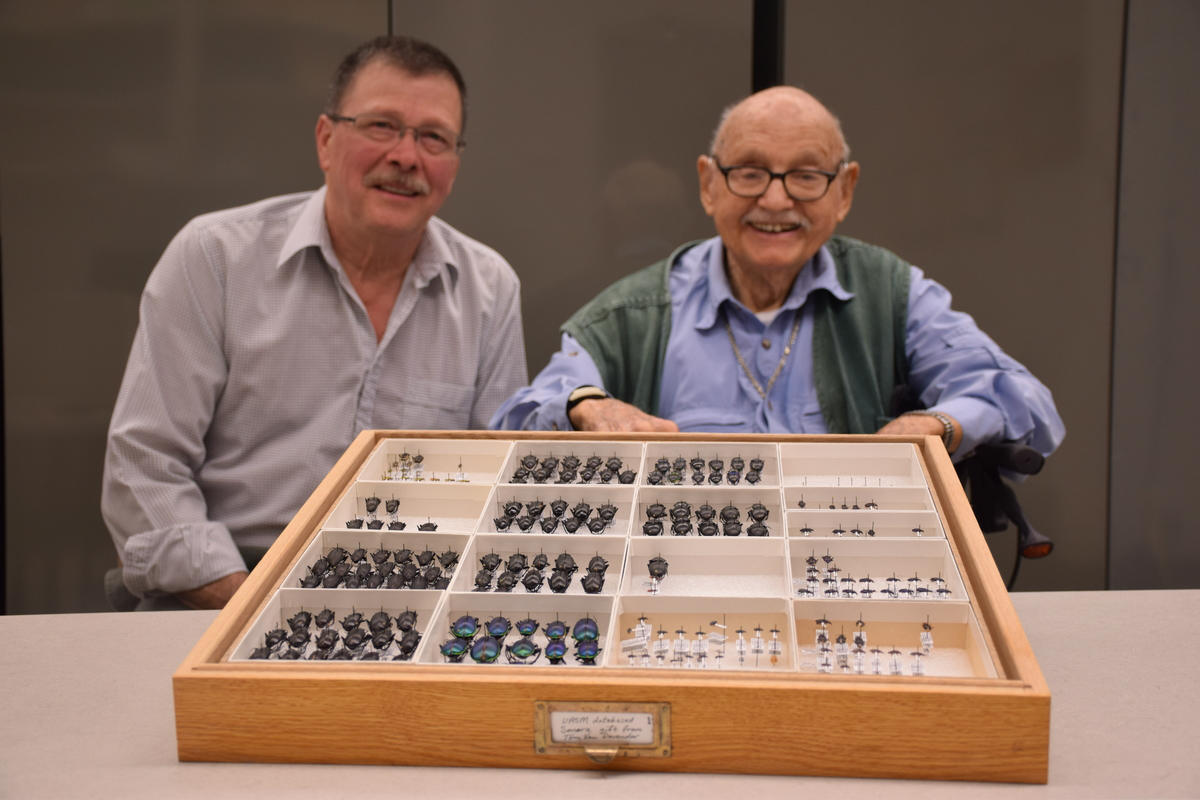
Danny Shpeley (left) and George Ball (right), have researched ground beetles together for 60 years. Photo credit: Michaela Ream
Danny Shpeley and George Ball have studied the carabidae ground beetle for the past 40 and 60 years respectively. And with more than 40,000 species around the world, the carabidae beetle has given them a lot to work with.
Since 1954, Ball has worked as the curator of the E.H. Strickland Entomological Museum. During his time as curator, the collection doubled in size and now houses more than one million specimens. Ball is now a professor emeritus with the Department of Biological Sciences.
In 1974, Shpeley began working alongside Ball as assistant curator, eventually taking over duties as curator in 1992. Under his care, the museum has seen continued abundant growth as well as the development of the virtual museum database, which has since become internationally recognized.
Since his retirement, Ball continues to visit the museum, and together he and Shpeley continued their research on the carabidae ground beetles. They have classified specimens from around the world, published dozens of studies, and discovered new species of the beetles from Mexico.
Shpeley plans to retire next year, closing a long chapter of research and inspiration for both men. Looking back at it all, both Dr. Ball and Shpeley fondly maintain that their research has always been "curiosity driven science."
What got you started studying the carabidae beetle?
Ball: *Laughing* "I hardly know where to begin. Well, I was in the scouts and I met a manwho was the merit badge examiner for the scouts, David Elsie. At the time I was interested more in general zoology, but David Elsie had this collection of beetles and that is what got me interested. So I started then collecting beetles and trying to learn about them whenever I could. I was 15 years old-now I'm 92."
What kept your interest for all these years to keep studying the beetles?
Ball: "The more I learned about them, the more interested I became.
Shpeley: "It's fascinating to see species new to science. We describe these species and the publication is the end result after 15 to 20 years. Maybe there are people who can sit down and look at the material and get a paper out in a year. But lots of our projects have been larger in scope and have taken longer to complete in that sense.
What is the identification process once you have found a beetle?
Shpeley: "When you collect things in the field, they are rough labeled by locality. You get all sorts of data, including where you collected the specimens, elevation, date, habitat, location. Then the specimens are brought back, they are cleaned, they're pinned, and labels are printed for the specimens; then it comes down to identifying them.
For some of these species, nobody may have worked on the group for over 100 years. These have very rough descriptions, some of them were two or three sentences long that were done 100 years ago, some of them were a bit longer. Then you construct the keys yourself to identify the species and start sorting them out yourself. The key is important, so that someone else, hopefully, if they have a specimen and they take it out from their collection, they can use the key and start running their specimen through it, and they are able to place a name on it."
Has there been anything notably interesting or unexpected that has come from the research?
Shpeley: "We found the new genus Ginema, which we placed into a new tribe within the Carabids. That species came out of Bolivia, and is only known from a single specimen. It is so unique that we placed it into a separate tribe as well; then we described the genus and the species. So I think that was a very nice find."
Ball: "That was really a surprise. Finding things that have not been seen before and describing them and making them available to others by publishing a thing like this is a really great part of this work."
How does it feel for this chapter of your research to be coming to an end now?
Shpeley: "It's been a fulfilling career, and that's why I've always thought of it as a professional career more than a job, if one wishes to term it that way. But yeah, as it's sort of coming to a close, I think these are things that I will miss in retirement. And again, it depends. George retired in '92, so that was 26 years ago, but he still comes in. I don't know if I will still come in for another 26 years after I retire, but I have said that I would be willing to come in and do certain things in the museum depending on what the situation is at that time. So as I say, you feel good for what you've done, but at the same time you feel sad that it is coming to an end. But I couldn't see myself doing anything differently."